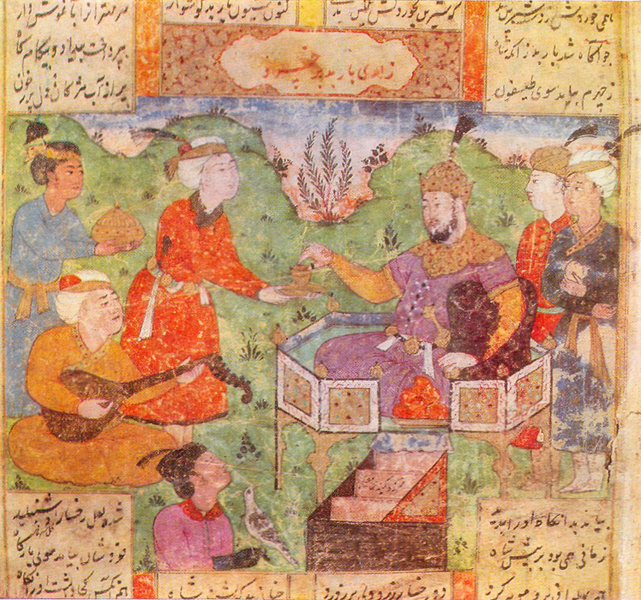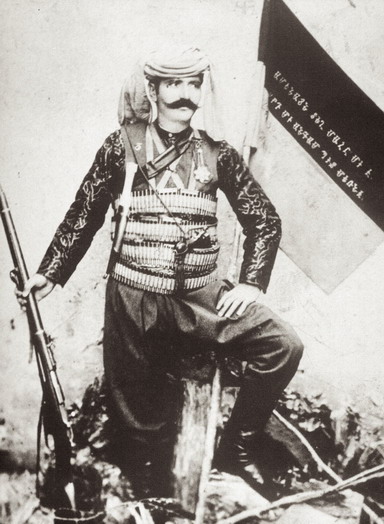|
Sheram
Sheram (born Grigor Talian, 20 March 1857, Alexandropol – died 7 March 1938, Yerevan) was an Armenian composer, poet-musician ('' gusan''), and folk musician (''ashug''). He is known as the founder of the modern gusan (Armenian popular composing) art. He created melodies and songs that are popular to this day: *"The Roses Blossom in the Garden" *"I Beg You, Mountains" *"She is Graceful" *"You are my Muse" *"Undefeated Fairy" *"We are Brothers" He authored "Like an Eagle", a song dedicated to Armenian national hero Andranik Ozanian.Andranik of Armenia, by Jr. Aram Bakshian // History Today, Vol. 43, April 1993 According to Vazgen I Vazgen I also Vazken I of Bucharest, (), born Levon Garabed Baljian ( hy, Լևոն Կարապետ Աբրահամի Պալճյան; September 20, 1908 – August 18, 1994) was the Catholicos of All Armenians between 1955 and 1994, for a total of 39 ..., Supreme Patriarch and Catholicos of All Armenians, this song is "one of the most popular and loved ... [...More Info...] [...Related Items...] OR: [Wikipedia] [Google] [Baidu] |
Alexandropol
Gyumri ( hy, Գյումրի, ) is an urban municipal community and the second-largest city in Armenia, serving as the administrative center of Shirak Province in the northwestern part of the country. By the end of the 19th century, when the city was known as Alexandropol,; hy, Ալեքսանդրապոլ it became the largest city of Russian-ruled Eastern Armenia with a population above that of Yerevan. The city became renown as a cultural hub, while also carrying significance as a major center of Russian troops during Russo-Turkish wars of the 19th century. The city underwent a tumultuous period during and after World War 1. While Russian forces withdrew from the South Caucasus due to the October Revolution, the city became host to large numbers of Armenian refugees fleeing the Armenian genocide, Armenian Genocide, in particular hosting 22,000 orphaned children in around 170 orphanage buildings. It was renamed to Leninakan; russian: Ленинакан during the Soviet period an ... [...More Info...] [...Related Items...] OR: [Wikipedia] [Google] [Baidu] |
Yerevan
Yerevan ( , , hy, Երևան , sometimes spelled Erevan) is the capital and largest city of Armenia and one of the world's List of oldest continuously inhabited cities, oldest continuously inhabited cities. Situated along the Hrazdan River, Yerevan is the administrative, cultural, and industrial center of the country, as its primate city. It has been the Historical capitals of Armenia, capital since 1918, the Historical capitals of Armenia, fourteenth in the history of Armenia and the seventh located in or around the Ararat Plain. The city also serves as the seat of the Araratian Pontifical Diocese, which is the largest diocese of the Armenian Apostolic Church and one of the oldest dioceses in the world. The history of Yerevan dates back to the 8th century BCE, with the founding of the fortress of Erebuni Fortress, Erebuni in 782 BCE by King Argishti I of Urartu, Argishti I of Urartu at the western extreme of the Ararat Plain. Erebuni was "designed as a great administrative an ... [...More Info...] [...Related Items...] OR: [Wikipedia] [Google] [Baidu] |
Gusans
Gusans ( hy, գուսան; Parthian for poet-musician or minstrel) were creative and performing artists - singers, instrumentalists, dancers, storytellers, and professional folk actors in public theaters of Parthia and ancient and medieval Armenia. In Armenia, the term gusan is often used as a synonym for ashugh, a singer-poet and bard. Etymology The word ''gusan'' is first mentioned in early Armenian texts of V c., e.g. Faustus of Byzantium, Moses of Chorene, etc. In Parsian language the earliest known evidence is from ''Vis o Rāmin'' by Fakhruddin As'ad Gurgani in the eleventh century. It was originally thought to have been a personal name. However in the 19th century Kerovbe Patkanian identified it as a common word possibly meaning "musician" and suggested that it was an obsolete Persian term, currently found in a form of a loanword in Armenian. In 1934 Harold Walter Bailey linked to origin of the word to the Parthian language. In Hrachia Acharian's opinion the word ... [...More Info...] [...Related Items...] OR: [Wikipedia] [Google] [Baidu] |
Andranik Ozanian
Andranik Ozanian, commonly known as General Andranik or simply Andranik;. Also spelled Antranik or Antranig 25 February 186531 August 1927), was an Armenians, Armenian military commander and statesman, the best known ''Armenian fedayi, fedayi'' and a key figure of the Armenian national movement, Armenian national liberation movement. From the late 19th century to the early 20th century, he was one of the main Armenian leaders of military efforts for the independence of Armenia. He became active in an armed struggle against the Ottoman Empire, Ottoman government and Kurdish irregulars in the late 1880s. Andranik joined the Armenian Revolutionary Federation (Dashnaktustyun) party and, along with other ''Armenian fedayi, fedayi'' (militias), sought to defend the Armenian peasantry living in their ancestral homeland, an area known as Western Armenia, Western (or Turkish) Armeniaat the time part of the Ottoman Empire. His revolutionary activities ceased and he left the Ottoman Empi ... [...More Info...] [...Related Items...] OR: [Wikipedia] [Google] [Baidu] |
Armenians
Armenians ( hy, հայեր, ''hayer'' ) are an ethnic group native to the Armenian highlands of Western Asia. Armenians constitute the main population of Armenia and the ''de facto'' independent Artsakh. There is a wide-ranging diaspora of around five million people of full or partial Armenian ancestry living outside modern Armenia. The largest Armenian populations today exist in Russia, the United States, France, Georgia, Iran, Germany, Ukraine, Lebanon, Brazil, and Syria. With the exceptions of Iran and the former Soviet states, the present-day Armenian diaspora was formed mainly as a result of the Armenian genocide. Richard G. Hovannisian, ''The Armenian people from ancient to modern times: the fifteenth century to the twentieth century'', Volume 2, p. 421, Palgrave Macmillan, 1997. Armenian is an Indo-European language. It has two mutually intelligible spoken and written forms: Eastern Armenian, today spoken mainly in Armenia, Artsakh, Iran, and the former Soviet ... [...More Info...] [...Related Items...] OR: [Wikipedia] [Google] [Baidu] |
Ashug
An ashik ( az, aşıq, ; tr, âşık; fa, عاشیق) or ashugh ( hy, աշուղ; ka, აშუღი) is traditionally a singer-poet and bard who accompanies his song—be it a dastan (traditional epic story, also known as '' hikaye'') or a shorter original composition—with a long-necked lute (usually a bağlama or ''saz'') in Turkic (primarily Turkish and Azerbaijani cultures, including Iranian Azerbaijanis) and non-Turkic cultures of South Caucasus (primarily Armenian and Georgian). In Azerbaijan, the modern ashik is a professional musician who usually serves an apprenticeship, masters playing the bağlama, and builds up a varied but individual repertoire of Turkic folk songs.Colin P. Mitchell (Editor), New Perspectives on Safavid Iran: Empire and Society, 2011, Routledge, 90–92 The word ''ashiq'' ( ar, عاشق, meaning "in love" or "lovelorn") is the nominative form of a noun derived from the word ''ishq'' ( ar, عشق, "love"), which in turn may be re ... [...More Info...] [...Related Items...] OR: [Wikipedia] [Google] [Baidu] |
Vazgen I
Vazgen I also Vazken I of Bucharest, (), born Levon Garabed Baljian ( hy, Լևոն Կարապետ Աբրահամի Պալճյան; September 20, 1908 – August 18, 1994) was the Catholicos of All Armenians between 1955 and 1994, for a total of 39 years, the 4th longest reign in the history of the Armenian Apostolic Church. The following three served for 39 years as Catholicos of All Armenians or Catholicos of the Great House of Cilicia: #Peter I (1019–1058) — Պետրոս Ա Գետադարձ (Catholicos of All Armenians), #Gregory II the Martyrophile (1066–1105) — Գրիգոր Բ. Վկայասէր ( Catholicos of the Great House of Cilicia) and #David IV (1590–1629), d. 1633 — Դավիթ Դ Վաղարշապատցի (Catholicos of All Armenians). The three longest reigning Catholicoi were: #) Nerses IV the Graceful (1166–1173) -- Սուրբ Ներսէս Դ. Կլայեցի (Շնորհալի), who served 53 years as Catholicos of the Great House of Cilicia, #) Constan ... [...More Info...] [...Related Items...] OR: [Wikipedia] [Google] [Baidu] |
1857 Births
Events January–March * January 1 – The biggest Estonian newspaper, ''Postimees'', is established by Johann Voldemar Jannsen. * January 7 – The partly French-owned London General Omnibus Company begins operating. * January 9 – The 7.9 Fort Tejon earthquake shakes Central and Southern California, with a maximum Mercalli intensity of IX (''Violent''). * January 24 – The University of Calcutta is established in Calcutta, as the first multidisciplinary modern university in South Asia. The University of Bombay is also established in Bombay, British India, this year. * February 3 – The National Deaf Mute College (later renamed Gallaudet University) is established in Washington, D.C., becoming the first school for the advanced education of the deaf. * February 5 – The Federal Constitution of the United Mexican States is promulgated. * March – The Austrian garrison leaves Bucharest. * March 3 ** France and the United Kingdom for ... [...More Info...] [...Related Items...] OR: [Wikipedia] [Google] [Baidu] |
1938 Deaths
Events January * January 1 ** The new constitution of Estonia enters into force, which many consider to be the ending of the Era of Silence and the authoritarian regime. ** State-owned railway networks are created by merger, in France ( SNCF) and the Netherlands (Nederlandse Spoorwegen – NS). * January 20 – King Farouk of Egypt marries Safinaz Zulficar, who becomes Queen Farida, in Cairo. * January 27 – The Honeymoon Bridge at Niagara Falls, New York, collapses as a result of an ice jam. February * February 4 ** Adolf Hitler abolishes the War Ministry and creates the Oberkommando der Wehrmacht (High Command of the Armed Forces), giving him direct control of the German military. In addition, he dismisses political and military leaders considered unsympathetic to his philosophy or policies. General Werner von Fritsch is forced to resign as Commander of Chief of the German Army following accusations of homosexuality, and replaced by General Walther ... [...More Info...] [...Related Items...] OR: [Wikipedia] [Google] [Baidu] |
Musicians From Yerevan
A musician is a person who composes, conducts, or performs music. According to the United States Employment Service, "musician" is a general term used to designate one who follows music as a profession. Musicians include songwriters who write both music and lyrics for songs, conductors who direct a musical performance, or performers who perform for an audience. A music performer is generally either a singer who provides vocals or an instrumentalist who plays a musical instrument. Musicians may perform on their own or as part of a group, band or orchestra. Musicians specialize in a musical style, and some musicians play in a variety of different styles depending on cultures and background. A musician who records and releases music can be known as a recording artist. Types Composer A composer is a musician who creates musical compositions. The title is principally used for those who write classical music or film music. Those who write the music for popular songs may ... [...More Info...] [...Related Items...] OR: [Wikipedia] [Google] [Baidu] |





